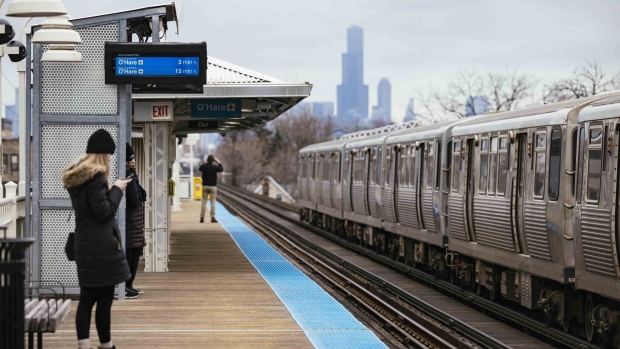Sep 6, 2023
Chicago Area Faces 30% Transit Cuts Without New Taxes, State Aid
, Bloomberg News

(Bloomberg) -- The Chicago area could suffer bus and rail-service cuts of 30% or more if state lawmakers don’t find new sources of money to replace federal aid that’s drying up by 2026, a regional planning agency says.
The area’s three transit systems, which average about a million daily rides combined in northeast Illinois, could see collective deficits expand to $1.19 billion in 2031 from about $730 million in 2026 after emergency pandemic funds run out and if no new money is allocated, the Chicago Metropolitan Agency for Planning said in a draft report this month.
The state in May 2022 mandated that the regional planning organization, which serves the city and surrounding counties, deliver recommendations for the long-term financial viability of regional transit by Jan. 1, 2024.
State lawmakers should weigh a mix of new revenue such as sales taxes on services, a parking tax or higher vehicle registration fees, according to the report. The agency is calling on the Illinois General Assembly to take up the proposals during its spring 2024 session, said Erin Aleman, its executive director.
The crux of the issue is that while federal aid gave the transit authorities a lifeline when fare-box collections plummeted during the pandemic, they now need to replace that funding, which currently makes up about 20% of operating funding. Rides have returned to about 60% of pre-pandemic levels and the drop in fares is the largest contributor to the anticipated funding gap in 2026, according to the report.
If that hole isn’t filled, Chicago and its environs could face service cuts of at least 30% to 40% as well as higher prices, according to the report. That could include loss of Metra commuter rail services for more than 100 cities, towns, and villages, elimination of Chicago Transit Authority train services for 20 Chicago neighborhoods and six suburbs, and cuts of over 150 bus routes, CMAP says.
It would amount to “pretty draconian cuts, the likes of which we haven’t seen before,” Aleman said.
Financial Options
The draft, which a CMAP steering committee is discussing for the first time on Wednesday, lays out a variety of options for the state legislature to help the region’s transit network recover from pandemic losses and address long-term issues concerning accessibility, climate and equality, Aleman said.
The Chicago region isn’t alone in funding or ridership challenges.
New Jersey Transit expects a $119 million budget gap for fiscal 2025, the last year the agency has pandemic-relief aid, according to the system’s board. The Washington Metropolitan Area Transit Authority in the nation’s capital projects a budget shortfall of $750 million in fiscal 2025, according to a June financial report.
States such as New York and California are offering bailouts to support their transit networks.
New York Governor Kathy Hochul and state lawmakers will increase the payroll tax on the largest businesses within New York City to 0.6% to help fund the Metropolitan Transportation Authority. The nation’s biggest transit system was at one point projecting a $600 million budget deficit this year. That gap was set to grow to $3 billion by 2025 as federal pandemic aid is set to run out.
Illinois House Speaker Chris Welch and state Senate President Don Harmon will review the report when it is released to the legislature, according to their spokespeople.
Metra is reviewing the report and will provide comments directly to the agency by a Sept. 22 deadline, according to Meg Thomas-Reile, a spokesperson. The Regional Transportation Authority, which oversees finances, fares and planning for the Chicago Transit Authority, Metra and Pace bus service in northeast Illinois, is also studying the recommendations.
“Public transit plays an essential role in the lives of millions of riders across the Chicago region and has the potential to reach even more people, but the system has been drastically underfunded for decades,” Leanne Redden, executive director of the RTA, said in an emailed statement.
©2023 Bloomberg L.P.






